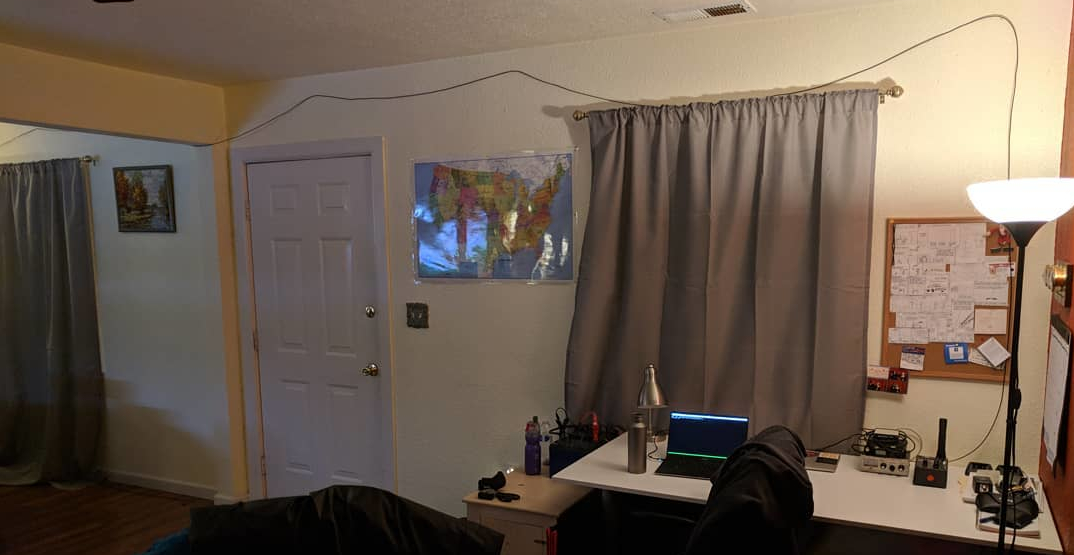
I really enjoy how well FT8 can work on random wire antennas with low power. It's incredible how little you can get away with.


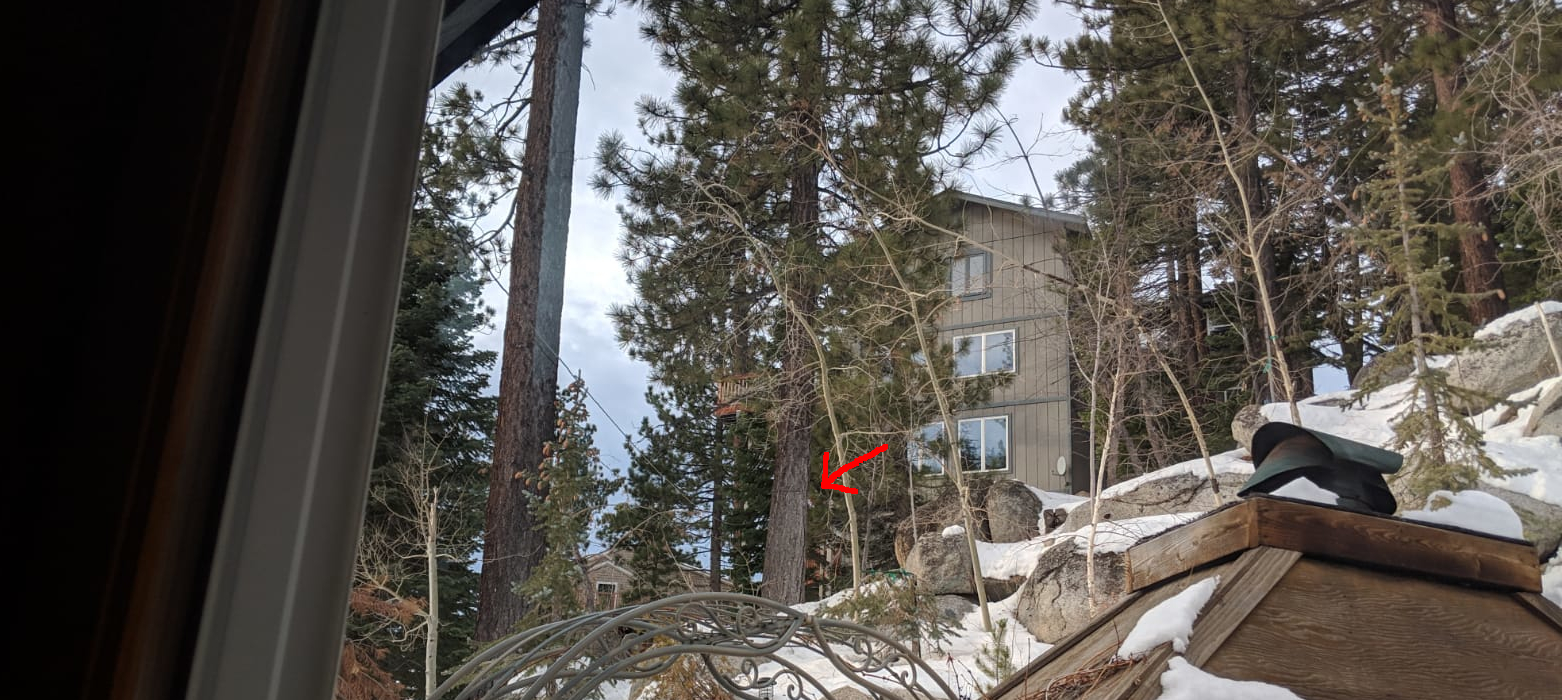
The rest of this page describes my old 100W HF station, which was active from 2018 through 2019. All the contacts logged here were FT8 with WSJTX. Confirmations were via TQSL.
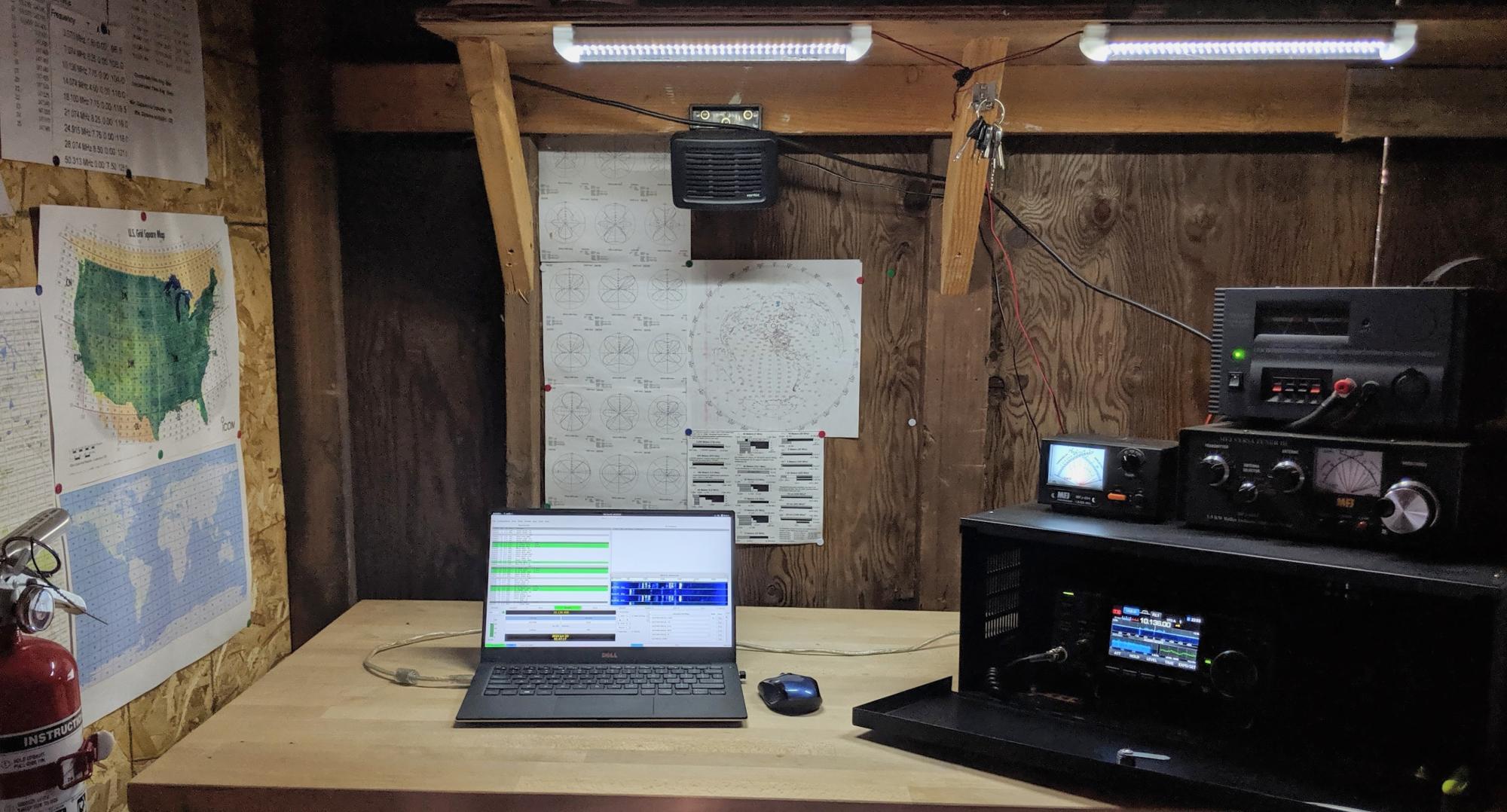
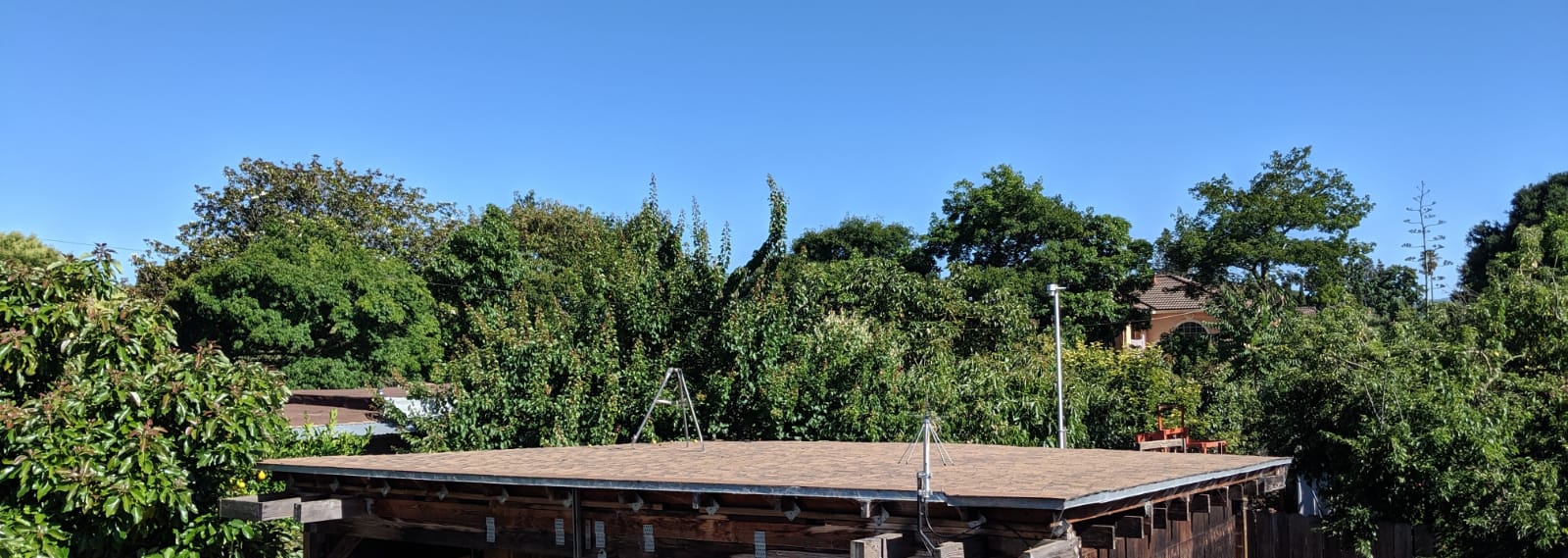
For my first couple years on HF, I used an "all-band" 102ft (31m) horizontal dipole antenna, which was strung North-South with the North end pointed about five degrees West of North. The North end was 17ft (5m) off the ground, and the South end was at 25ft (8m). The wire was #14 (1.6mm) uninsulated copper.
Totals: 622 QSOs, 503 Confirmed (80.9%) Confirmed DXCC Countries (41): ALASKA (5) ANTARCTICA ARGENTINA (3) ASIATIC RUSSIA (3) AUSTRALIA (2) BALEARIC ISLANDS BELIZE BOLIVIA BRAZIL (4) CANADA (17) CANARY ISLANDS CHILE (3) CHINA COLOMBIA (2) COSTA RICA CUBA (2) ENGLAND FINLAND FRANCE GUATEMALA HAWAII (8) HONG KONG INDONESIA (14) JAMAICA JAPAN (60) MAURITANIA MEXICO (2) NEW CALEDONIA NEW ZEALAND (8) NICARAGUA NORWAY PARAGUAY PUERTO RICO REPUBLIC OF KOREA (3) REPUBLIC OF SOUTH AFRICA SPAIN SWEDEN TAIWAN (2) UNITED STATES OF AMERICA (341) VENEZUELA WEST MALAYSIA Confirmed US States: AK(05) AL(08) AR(03) AZ(16) CA(51) CO(13) CT(02) DE(02) FL(10) GA(08) HI(08) IA(05) ID(08) IL(15) IN(05) KS(06) KY(07) LA(01) MA(05) MD(03) ME(01) MI(05) MN(09) MO(04) MS(04) MT(02) NC(08) ND(06) NE(03) NH(01) NJ(06) NM(07) NY(01) OH(11) OK(04) OR(10) PA(04) SC(03) SD(01) TN(08) TX(31) UT(09) VA(06) WA(19) WI(07) WV(02) WY(01)
| Callsign | Grid | Date UTC | Hdg | Dist | Band | RST TX/RX | DXCC |
|---|---|---|---|---|---|---|---|
| ZS1CF | JF96 | 2018-09-22 | E | 10187mi | 40m | -13/-18 | R.O. SOUTH AFRICA |
| DP1POL | IB59 | 2018-01-28 | SE | 9179mi | 20m | -20/-13 | ANTARCTICA |
| YC6RMT | NJ81 | 2018-12-23 | WNW | 8751mi | 40m | -09/-13 | INDONESIA |
| YG0TUR | OI33 | 2018-01-12 | W | 8690mi | 40m | -10/-13 | INDONESIA |
| YD1WCK | OI33 | 2018-12-25 | W | 8684mi | 40m | -02/-17 | INDONESIA |
| YC4KRZ | OI27 | 2018-02-25 | WNW | 8635mi | 40m | -10/-18 | INDONESIA |
| YE6YE | NJ93 | 2018-03-05 | WNW | 8586mi | 40m | +01/-16 | INDONESIA |
| YC6JRT | NJ93 | 2018-12-25 | WNW | 8582mi | 40m | +00/-14 | INDONESIA |
| YB6DE | NJ84 | 2018-03-04 | WNW | 8561mi | 40m | -17/-18 | INDONESIA |
| YC2JPO | OI52 | 2018-12-25 | W | 8541mi | 40m | +01/-13 | INDONESIA |
| YB2CTE | OI53 | 2018-12-22 | W | 8507mi | 40m | -07/-06 | INDONESIA |
| 9M2CNC | OJ03 | 2018-12-23 | WNW | 8470mi | 40m | -08/-09 | WEST MALAYSIA |
| YG5TKN | OJ20 | 2018-03-18 | WNW | 8453mi | 40m | -10/-10 | INDONESIA |
| YC7CCP | OI49 | 2018-09-22 | WNW | 8271mi | 40m | -03/-17 | INDONESIA |
| YG7SPN | OI67 | 2018-03-04 | W | 8144mi | 40m | -06/-12 | INDONESIA |
| VK1MA | QF44 | 2018-04-14 | SW | 7581mi | 17m | -11/-11 | AUSTRALIA |
| YB8RW | PJ21 | 2018-03-18 | W | 7386mi | 40m | +05/-13 | INDONESIA |
| VK2AHE | QF57 | 2019-06-23 | SW | 7343mi | 40m | -15/-14 | AUSTRALIA |
| YD8UXV | PJ23 | 2018-03-05 | W | 7276mi | 40m | -18/-16 | INDONESIA |
| ZL4AS | RE43 | 2018-02-04 | SSW | 7153mi | 15m | -21/-18 | NEW ZEALAND |
| ZL4TT | RE54 | 2018-04-14 | SSW | 7062mi | 17m | -17/-07 | NEW ZEALAND |
| ZL3GAV | RE66 | 2019-06-23 | SSW | 6932mi | 40m | -14/-17 | NEW ZEALAND |
| VR2XYL | OL72 | 2018-02-26 | WNW | 6910mi | 20m | -09/-23 | HONG KONG |
| ZL2RX | RE68 | 2018-02-24 | SSW | 6796mi | 20m | -19/-21 | NEW ZEALAND |
| PY1FI | GG87 | 2018-01-20 | ESE | 6597mi | 15m | -19/-17 | BRAZIL |
| ZL2IFB | RF80 | 2018-04-13 | SSW | 6586mi | 20m | -12/-06 | NEW ZEALAND |
| ZL1BD | RF72 | 2018-04-10 | SSW | 6553mi | 20m | -14/-03 | NEW ZEALAND |
| ZL3TE | RF73 | 2018-02-04 | SW | 6531mi | 17m | -11/-09 | NEW ZEALAND |
| ZL3CW | RF73 | 2018-01-21 | SW | 6527mi | 15m | -13/-08 | NEW ZEALAND |
| BX4AL | PL05 | 2018-01-13 | WNW | 6470mi | 17m | -11/-12 | TAIWAN |
| BV1EK | PL05 | 2018-12-23 | WNW | 6447mi | 40m | -10/-12 | TAIWAN |
| PY2MR | GG66 | 2018-02-25 | ESE | 6445mi | 40m | -07/-15 | BRAZIL |
| LU5CQC | GF05 | 2018-01-28 | ESE | 6434mi | 20m | -24/-17 | ARGENTINA |
| LU8EKC | GF05 | 2018-01-16 | ESE | 6428mi | 30m | -07/-20 | ARGENTINA |
| PU2LEW | GG66 | 2018-01-21 | ESE | 6423mi | 15m | -16/-11 | BRAZIL |
| PY2BEK | GG55 | 2018-02-26 | ESE | 6395mi | 17m | +04/-13 | BRAZIL |
| 5T2AI | IK28 | 2018-04-10 | NE | 6371mi | 40m | -10/-14 | MAURITANIA |
| CE7VPQ | FE36 | 2018-01-21 | SE | 6349mi | 20m | -11/-01 | CHILE |
| FK8DD | RG37 | 2018-04-10 | SW | 6203mi | 20m | -16/-01 | NEW CALEDONIA |
| EA6VQ | JM19 | 2018-01-07 | NNE | 6077mi | 80m | -07/-19 | BALEARIC ISLANDS |
Click here for a list of all contacts I made with the old antenna, confirmed and unconfirmed.
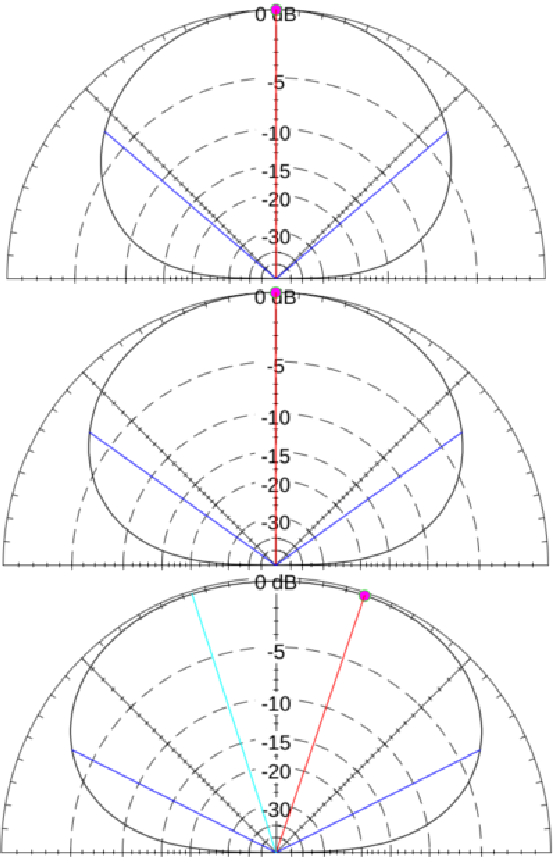
You might recognize the length as a G5RV antenna: that length works well because it's "equally bad" for all the amateur radio bands, but it didn't have the correct ground clearance or length of ladder line to really be called a "G5RV".
The full run was about 240ft, with the antenna strung between rope on ceremic insulators. It was tied off to a TV satellite dish on the north end of the roof, and threaded through a pulley in the tree to a hanging cinderblock counterweight on the south end.
The antenna was fed with ~30ft of 450 Ohm ladder line, which ran down at a 45-degree angle north for 15ft and then just out of reach parallel to the ground into the shack, located under the center of the north leg. The ladder line ran through a knife switch (for grounding it when not in use) to a manual T-network antenna coupler, which had a built-in 1:1 current balun.
The manual antenna coupler was a little silly, but since I generally stuck to FT8 I just had a table of the right settings and it was quick enough. A T-network is laughably simple compared to an L-network autocoupler, and I have a deep love for "stupid" things that work. It had an air core inductor I could put my arm through, and could match any frequency I ever tried to 2:1 or better, including 160m.
The ladder line was an important part of making this work: the antenna had extremely high impedence at several of the frequencies I liked to use it on, in particular 30m, so the loss in coax would be untenable (and the voltage might actually exceed its tolerance).
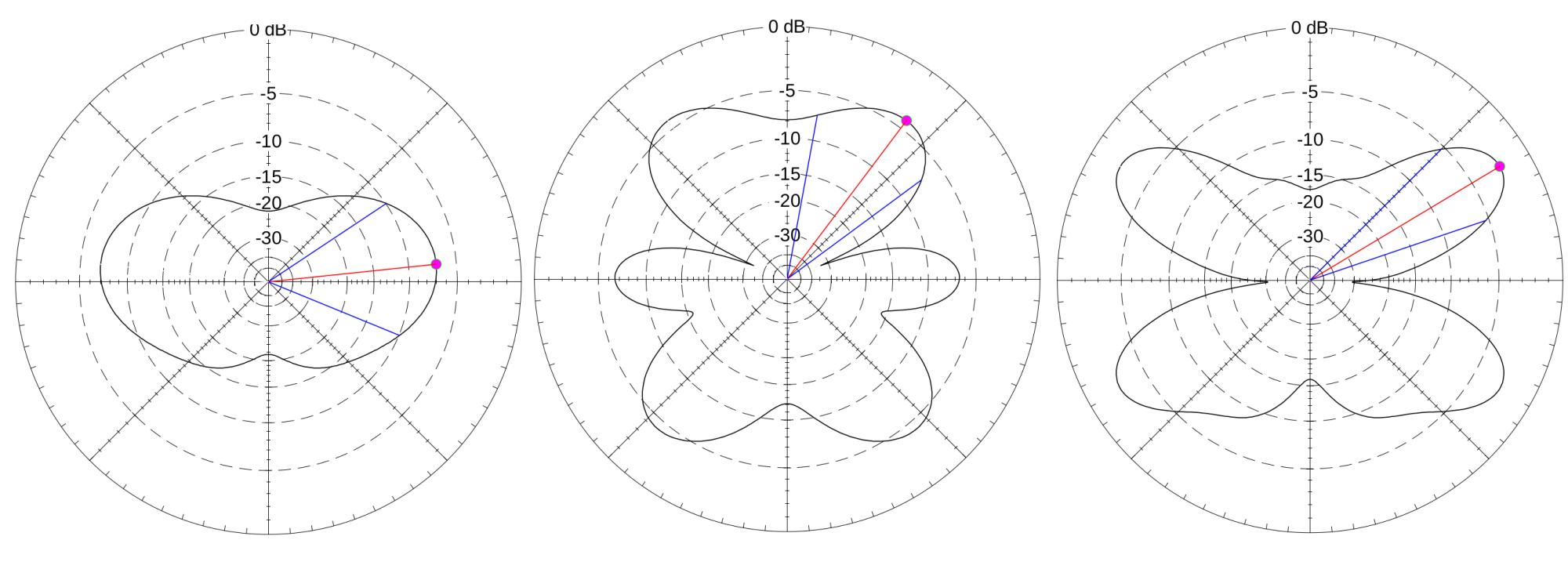

At 20m and above, as illustrated by the figures, an antenna of this size starts to develop gain in frequency dependent "star" patterns. I had lots of success all the way up to 15m (21MHz). Beyond that, the radiation pattern starts to distort North due to the slope of the antenna, and that's not where you want to point for success at those high frequencies. I rarely made non-line-of-sight contacts on these bands.
I was sort of surprised how well it worked on 40m, being barely an 1/8th of a wavelength above the ground at that frequency. All of my contacts more than 8000 miles away were on 40m, with one exception (which happened to be placed perfectly in one of the predicted gain lobes).
This is all a nice demonstration of how resonance doesn't matter much on HF, especially lower HF: if you can hear the noise, it's good enough. The coupler exists only to present the 50 Ohm load the transmitter was designed for.
Most 80m and the majority of distant 40m contacts required the full 100W transmit power of my transmitter. On good days I was able to work USA hams with 5W on 40m. On 30m and above, 5W was often enough for all but the most distant contacts. Several QSLs with Japan on 20m were made with one watt!

The below plots show all FT8 contacts made with this old antenna. All distances are in miles, and the colors run through the rainbow from 160m to 6m.
The first set just show the location of contacts at three different "zoom" levels. This was an attempt to empirically validate the radiation pattern predicted by EZNEC. For the most part, they are too skewed by population density to draw statistically significant conclusions... but the "star pattern" which begins at 20m is pretty clearly there. Compare 20m and 17m as well.
The next set are scatterplots of signal reports on each band: the first shows the signal report I received (e.g. how well they heard me) as a function of distance (log x-axis), and the second shows it as a function of the signal report I sent (e.g. how well I heard them).
The last set show the distance/band of each contact, arranged around the circle by time of day rather than the direction. The really good DX I got on 40m consistently around sunrise sticks out.